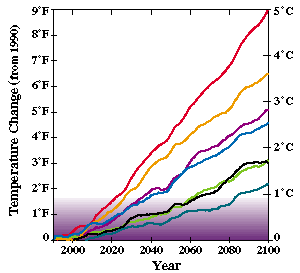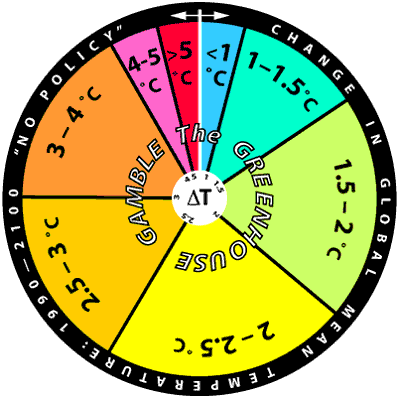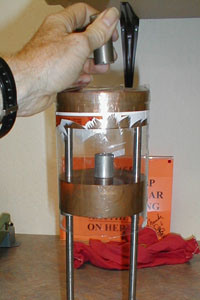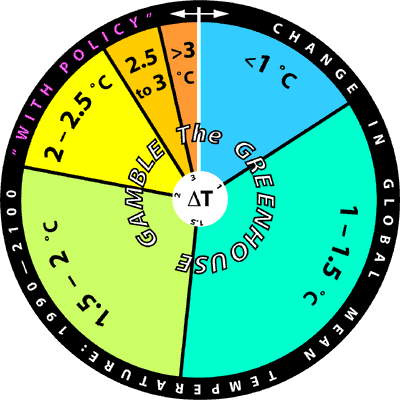
Weather Future
The effects of global warming.
According to the IPCC a panel of scientists convened to study climate.
The data.
The temperature of the earth has risen between 0.3 to 0.6 °C over the last 100 years.
The oceans have risen between 10 and 25 cm.
The concentration of carbon dioxide, a greenhouse gas, has risen from 280 ppm 100 years ago to 380 ppm today.
The amount of CO2 in the atmosphere is the largest it has been in the last 600,000 tears and probably in the last 2.5 million years.
Almost all scientists agree that humans are a major contributor to the increase in CO2 in the atmosphere due to the burning of fossil fuels.
The 20th century was the warmest since the 15'th century.
What does this mean?
The predictions for the future as a graph.

The IPCC predicts there will be an increase in temperature by 2 °C by 2100 (ranging from 1 to 3.5 °C.) This graph is from MIT and shows a larger range.
Each of these graphs has a different probability, this can be appreciated by making a game-board spinner with the likelihood of each temperature increase proportional to the angle of the pie-slice in the spinner.
Here is a page from MIT that gives you a sense of the possible changes in temperature by using a spinner.
http://mit.edu/globalchange/www/wheel.degC.html
Here is the spinner.

Place a spinning arrow at the center of this circle and spin it to
find an estimate for the rise in temperature of the earth over the
next hundred years.
The rise of sea level
There are two contributions to the rise in sea level, the thermal expansion of ocean water as it warms, and the added runoff from land based glaciers and ice caps when they melt.
Thermal expansion of water
Theprediction of the IPCC is that the oceans will rise 60 cm (with a range of 15 to 95 cm)
Experiment
Fill a 1 liter volumetric flask with water to a marked line.
Add food coloring , I use blue, until the water is visible.
Put the flask on a hot plate and watch it rise as the water expands. The water in my flask rose 3 cm.
Melting of Ice floating on the ocean versus ice on land
If you place an ice cube so that it is floating in a glass of water, then fill the glass of water until it overflows. Then, dry the outside of the glass and let the ice cube melt, no water will flow out of the glass. This represents the resukt of the melting of floating ice in the oceans.
If you support an ice cube over a glass of water on barbeque skewers and then fill the glass until it overflows and then dry the outside, as the ice cube melts the glass will overflow, this represents glaciers and ice caps on land.
When glaciers or ice caps on land melt sea level rises, when ice in the sea melts sea level remains the same.
However, if the floating west Antarctic ice cap were to collapse and melt it would release the land bound east Antarctic ice cap to flow into the sea causing a rise in sea level.
Ice floating on water displaces its weight of liquid water, when it melts it still displaces its weight, and so it displaces the same amount of water as before since water liquid is denser than water ice.
However, when water ice on land melts the liquid water flows into the ocean causing the level of the ocean to rise.
Feedback positive and negative
Positive feedback: try to lift a magnet with another magnet so that it floats in the air. It is impossible because of positive feedback, the closer the magnets become the larger the force between the magnets, the force gets larger fast enough that humans cannot react in time!
Negative feedback: When a magnet moves near and electrical conductor it makes the conductor into an electromagnet that opposes the change in motion of the magnet thus, adding layers of coper to the system allows you to fly a magnet.

A neodymium magnet can be floated between two slabs of copper due to
negative feedback.
If the climate warms, polar ice melts exposing water and land. The dark water and land absorb more solar radiation, making the climate warmer. this is a positive feedback.
If carbon dioxide increased which made more plants grow then the plants removed carbon dioxide this would be negative feedback.
What to do about it.
The problem is not burning fuel, the problem is burning fossil fuel, oils gas and coal from underground.
Burn a stick from a tree, this stick was carbon dioxide in the air recently! So we just became part of the carbon cycle. Replacing carbon dioxide in the air that had been removed by the tree.
Burn a fossil fuel, a propane torch. This propane came from underground. Plants removed the carbons from the atmosphere millions of years ago and then they were buried, now we are releasing them back into the atmosphere.
You can help the problem by reducing your use of fossil fuels.
Here's the spinner if we take action

http://mit.edu/globalchange/www/wheel.policy.degC.html
Use less energy,
Make the energy you use renewable.
Drive less, it will cost you less.
Use bio diesel.
Use solar power, wind power, or nuclear power.
|
Scientific Explorations with Paul Doherty |
|
21 November 2006 |